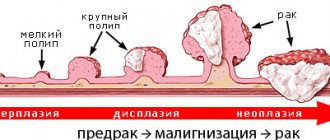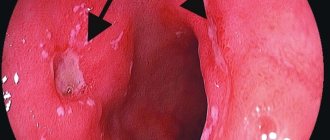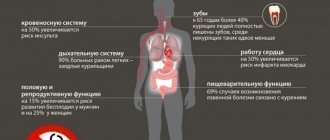Causes
Malignancy of gastric and duodenal ulcers is a very common occurrence. The reasons for the development of the process are currently not fully understood. At the same time, doctors name internal and external factors under which ulcer malignancy most often occurs. The main internal reasons for the appearance of malignant ulcers are considered to be the following:
- Reduced natural defense reactions.
- Hormonal imbalances.
- Metabolic disease.
- Genetic predisposition.
- Stress and nervous tension for a long time.
Among the external factors that increase the risk of malignancy, the following can be identified:
- Poor nutrition.
- Bad habits.
- Increased radiation, both natural and artificial.
- Unfavorable environmental conditions.
- Harmful chemical effects.
The clinical picture of malignancy is always associated with a general deterioration of the condition. This allows patients diagnosed with a peptic ulcer to promptly consult a doctor and undergo the necessary examination.
Attention! At the early stage of malignancy of a gastric ulcer during surgical treatment, the probability of a positive prognosis is very high.
https://youtu.be/nQsTzkBU5y8
Symptoms
Symptoms of malignancy, which, first of all, indicate the beginning of the process of tissue degeneration, are associated with a change in the nature of pain. The pain syndrome takes on a vague, aching character.
Moreover, such a symptom of malignancy is constantly present. In addition, pain from a stomach ulcer worsens at night during the period of relaxation of the body. Against this background, the patient experiences a general deterioration in health.
A malignant gastric ulcer also manifests itself in the process of development with other signs:
- Deterioration of appetite, which leads to weight loss and deterioration of the skin.
- Changes in taste preferences, in particular, aversion to meat dishes are often observed.
- Digestive disorder. Constipation and diarrhea often occur, and after eating, belching appears with an unpleasant taste and smell.
- Nausea after eating. Vomiting may occur periodically, which does not bring relief.
Risks of malignancy
An ulcer can turn into cancer. There are many reasons for this process, so several provoking factors often work simultaneously. Most often, an ulcer caused by infection of the body, in particular the gastrointestinal tract, by Helicobacter, undergoes malignancy. With many years of contamination of the epithelial surface of the digestive organ with pathogenic flora, a chronic form of gastritis develops, accompanied by the gradual replacement of healthy organ tissue with inert connective structures with an ulcerated surface. Cancerous transformation of an ulcerative defect on the mucosa occurs against the background of progressive changes that occur over time in the membrane.
The risk of developing cancer in such patients is higher if there is a genetic predisposition. Statistics on malignancy: 2-14% of ulcer patients present with cancer, 80% of which are at a late incurable stage. Basically, an advanced form of ulcer turns into cancer.
Diagnostics
It is possible to detect malignancy of a stomach ulcer at an early stage only in cases where a person, due to the nature of his work, has to undergo routine medical examinations.
But a positive prognosis is also highly likely if the diagnosis of malignancy of a gastric ulcer was carried out when the initial symptoms appeared. The basis for making an accurate diagnosis are the results of the following instrumental examinations:
- Fibrogastroduodenoscopy. During the procedure, the surface of the mucous membrane is examined using a special probe in order to clarify the location of the ulcer and its size. It is also necessary to take tissue from the affected area for histological examination.
- Radiography. During the procedure, a contrast agent is used to reveal the jagged edges of the affected area, which is a sign of malignancy.
Can an ulcer turn into cancer?
The fact of malignant degeneration of a stomach ulcer is considered a reality. But the frequency of occurrence of such a phenomenon is still a controversial value. According to many experts, 2-14% of cancer patients had a peptic ulcer before the formation of a malignant neoplasm.
The greatest amount of malignancy is observed in long-term non-healing ulcers, the size of which ranges from 2 cm to 2.5 cm. In such cases, the radiologist notes an infiltration compaction of the outer edge of the defect in the gastric mucosa. Further progression of ulcerative lesions in the form of an increase in the volume of the focus of destruction and the formation of roller-shaped borders of the ulcer causes oncological alertness and precancer. Patients in such cases should immediately undergo a comprehensive diagnosis of the state of the digestive system.
Treatment
Treatment of malignant gastric ulcers is almost always performed surgically. The extent of surgical intervention depends on the location of the formation and the degree of damage to surrounding tissues and organs. The following types of operations can be performed:
- Gastrectomy, which involves removing the tumor along with the stomach.
- Gastric resection, during which the lower part of the digestive organ is removed.
- Excision of part of the stomach, which is possible at an early stage of the disease.
Conservative therapy is considered less effective when a cancer process is detected. It can be performed in cases where the condition of the body does not allow the operation.
Medicines
Treatment methods for malignant gastric ulcers using medications are aimed at reducing the rate of cell degeneration and stabilizing the human condition. For this purpose, medications are prescribed that allow:
- Reduce the secretion of gastric juice.
- Relieve pain syndrome.
- Reduce the inflammatory process in the affected area.
- Restore stomach functions and improve the digestion process.
- Strengthen reparative processes on the mucous membrane.
- Normalize the activity of the autonomic and central nervous systems, as well as subcortical structures.
- Boost immunity.
Folk remedies
Folk remedies for the treatment of malignant gastric ulcers are considered ineffective. But with their help, you can remove the unpleasant symptoms that accompany the disease, and therefore alleviate the patient’s condition.
In addition, permitted juices are very healthy, as they allow you to saturate the body with vitamins. Typically, doctors allow the use of the following types of juices during treatment with conservative methods:
- Potato, which reduces the acidity of gastric juice and has anti-inflammatory properties. You should take the drink no later than 10 minutes after preparation and half an hour before meals. To prevent exacerbations of stomach ulcers, in the absence of contraindications, you are allowed to drink half a glass of juice for two weeks. After this, you must take a break for at least 14 days.
- Carrot, which contains a huge amount of useful substances. For stomach ulcers, it is recommended to drink the juice half an hour before meals. If there are no intolerances or contraindications, then the volume of the drink can be gradually increased to 200 g. It is recommended to take the juice for 21 days, after which you need to take a month's break.
Advice! When treating ulcers, doctors often allow you to drink potato and carrot juice every morning on an empty stomach. Within a couple of weeks, this method can significantly improve your overall well-being.
Diet
If conservative treatment of a malignant gastric ulcer is carried out, then during this period the patient must follow a strict, gentle diet. The main principle of menu planning is the absence of foods in the diet that may have an irritating effect. These are hot, salty and spicy dishes, carbonated drinks, mushrooms, fatty meats and fish, canned food, semi-finished products, strong tea and coffee.
Advice! The diet must be agreed with the doctor.
It is important to reduce the load on the digestive organ as much as possible by providing split meals. You need to eat often, but the portions should be small. This approach will facilitate effective treatment with medications.
After surgical treatment of a malignant gastric ulcer, the diet is developed individually depending on the complexity of the operation and the patient’s condition. At the initial stage of recovery, exclusively ground food is consumed; the transition to a different consistency is carried out gradually. New products are included in the diet in minimal quantities, and the patient’s reaction is monitored.
Physiotherapy
Physiotherapeutic methods can also be used in the treatment of decubital ulcers of the oral cavity. They help reduce the activity of the inflammatory process, relieve pain, speed up the processes of restoration of affected tissues, and also successfully fight microorganisms in the wound.
As a rule, for this disease the following is used:
To neutralize microorganisms that infect the ulcer, its surface is irradiated with EF radiation. Other effects of ultraviolet rays are the activation of microcirculation in the affected area and improved tissue nutrition. The course of treatment includes 4 daily procedures, starting with 1 biodose and increasing the dose by 0.5 with each subsequent session.
If it is not possible to use EF, exposure of the wound to the integral spectrum is permissible. The initial radiation dose should be 2 BD and increase by 1 BD with each subsequent session. In this case, the course of treatment is longer - it consists of 5-6 treatments.
To speed up the process of epithelization of the ulcerative defect, local darsonvalization is applied directly to the affected area. They act for 1-2 minutes in a course of 4-5 sessions.
Aerosol therapy is prescribed for large ulcers. Drugs that activate reparative processes and have an anti-inflammatory effect are simply sprayed over the surface of the wound. You can combine this type of physiotherapy with exposure to a constant high-voltage electric field, as well as with irrigation of the oral cavity with antiseptic solutions.
If, despite the complex treatment carried out, the ulcer does not heal within 7 days, further examination is necessary, ideally a biopsy.
Complication
If a malignant gastric ulcer is not diagnosed at the initial stage, then a complex operation will be necessary. In particular, removal of the stomach may be necessary to eliminate a stomach tumor.
In order to minimize the risks of complications, it is necessary to provide for rehabilitation under the supervision of a doctor. It is important to carry out measures that promote scarring of sutures and are aimed at restoring the motor-evacuation function of the gastrointestinal tract.
Since surgical treatment is indicated for malignant gastric ulcers, complications may occur, as after other surgical interventions. It can be:
- Postoperative bleeding.
- The development of an inflammatory process at the junction of the intestines and the rest of the stomach, which will require a new operation.
- Peritonitis due to wound infection.
In order to reduce the risks of tissue malignancy, after diagnosing a stomach ulcer, you should follow all the doctor’s recommendations and lead a healthy lifestyle. It is important to give up bad habits and minimize stress. A positive attitude will help successful treatment and reduce the likelihood of malignancy of damaged areas on the mucous membrane of the digestive organ.










